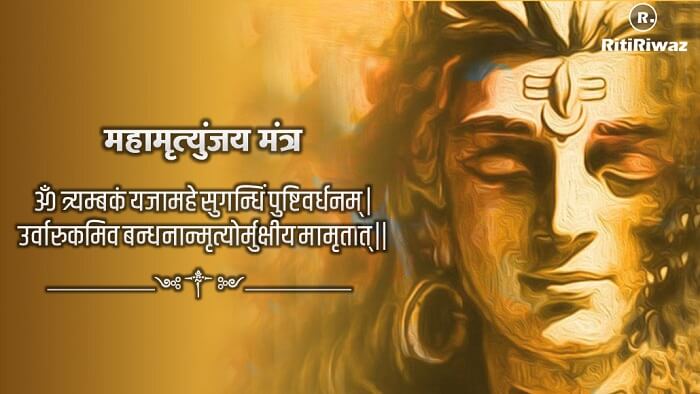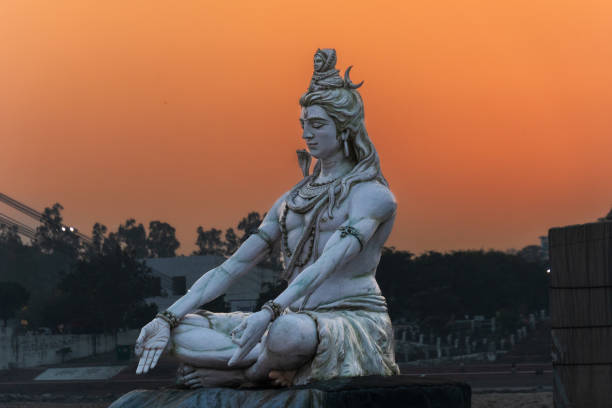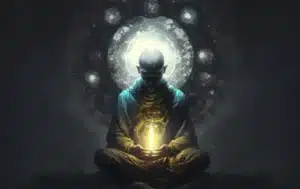The Mahamrityunjaya mantra is derived from the Vedas, which are sacred texts of Hindus. People also call it the “Great Death-Conquering Mantra”. This mantra was created to invoke the three-eyed god, Lord Shiva or Tryambakam. When people chant this mantra, they ask Shiva to protect them from death and ignorance. They also hope to awaken spiritually and live forever.
The Origin of Mahamrityunjaya mantra
Mahamrityunjaya mantra appears in the Rig Veda (The oldest of the four Vedas) and was created by the sage Rishi Markandeya.
The Mahamrityunjaya mantra is a powerful chant. It is about achieving inner balance and enlightenment. Its purpose is to help free oneself from physical limitations, conquer the fear of death and to achieve spiritual growth.
The words of this mantra explain the connection between reality, consciousness and divinity. Its composition allows it to work on many levels – physically, emotionally and mentally. This is related to the Hindu trinity – Brahma the creator, Vishnu the preserver and Shiva the transformer.
Chanting the Mahamrityunjaya Sutra has long aided spiritual progress. Its rhythm promotes mental peace. The simple sound of the mantra makes it easy to remember and recite, suitable for both experts and beginners.
Meaning of Mahamrityunjaya mantra
The Mahamrityunjaya Mantra has ancient origins in Vedic texts. It expresses a powerful appeal to embrace life’s journey. This sacred chant seeks spiritual freedom and bodily wellness. Its meaning resonates deeply, entreating divine grace for existential balance. The mantric verses hold profound wisdom, guiding souls towards transcendent realization.
This mantra, dedicated to Lord Shiva, is structured as follows:
“Om Tryambakam Yajamahe
Sugandhim Pushtivardhanam
Urvarukamiva Bandhanan
Mrityor Mukshiya Maamritat”
The mantra starts by honoring Lord Shiva, known as “Tryambakam,” meaning the three-eyed lord. His third eye symbolizes his ability to perceive reality beyond the physical world.
Next, it praises Shiva’s divine qualities, calling him “Sugandhim Pushtivardhanam” – the fragrant one who nurtures growth and prosperity.
The most evocative part compares liberation to a ripe cucumber easily separating from its vine: “Urvarukamiva Bandhanan.” This metaphor expresses the desire for freedom from mortal constraints.
Finally, the mantra pleads: “Mrityor Mukshiya Maamritat,” seeking liberation from the cycle of death and rebirth, and yearning for immortality or “Moksha.”
Benefits of chanting the Mahamrityunjaya mantra
The Mahamrityunjaya mantra is an ancient Sanskrit chant. It’s known as the Great Death-Conquering mantra. People respect it for powerful vibrations. They believe these vibrations give long life and protect from calamities.
As you chant this mantra, you may feel a deep calm in your mind. The mantra is meant to transform you. It leads to a meditative state that reduces stress and anxiety. Continuously chanting the mantra helps focus your mind. It frees your mind from negative thoughts.
Physically, the mantra’s vibrations may help your body. Chanting involves rhythmic breathing. This naturally improves your pranic energy flow. It may strengthen your immune system and aid healing.
The Mahamrityunjaya mantra is said to affect your subconscious mind. Chanting creates positive spiritual vibrations that purify karma. It’s like signaling the universe for protection and health – for yourself and others.
There are psychological benefits too. Embracing the mantra’s essence helps overcome fears, especially the fear of death. The mantra is linked to existential truth and eternal life. This can help develop courage and acceptance towards life’s challenges.
How to Chant the Mahamrityunjaya mantra
Chanting the Mahamrityunjaya mantra requires mental focus, vocal precision, and spiritual intent. This sacred ritual is more than just vocal recitation; it integrates meditation and concentration aspects. Here’s how to chant the Mahamrityunjaya mantra effectively:
- Purify your space and self: Begin by purifying your immediate environment. Choose a serene, clean space where you can sit undisturbed. Purification extends to the self as well; take a moment to cleanse your mind of mundane thoughts and surrender yourself to the divine energy.
- Assume a comfortable posture: Take a comfortable sitting position, preferably cross-legged, with your spine upright but relaxed. Rest your hands on your knees in a natural, open-palm position, allowing the flow of energy.
- Close your eyes and breathe: Close your eyes gently, turning your gaze inward. Take a few deep, rhythmic breaths, letting each exhalation release any residual tension or restlessness.
- Invocation: Initiate the process with a simple invocation to Lord Shiva, seeking his divine grace and guidance. You may say silently to yourself, “I surrender to the divine will and guidance of Lord Shiva”.
- Chant the mantra: Begin chanting the mantra, “Om Tryambakam Yajamahe Sugandhim Pushtivardhanam Urvarukamiva Bandhanan Mrityor Mukshiya Maamritat”. You can do so silently within your mind or softly articulate the words, letting their resonance fill your being.
- Synchronize with breath: Try to synchronize the chanting with your breath. This harmonizes the body, mind, and spirit, amplifying the mantra’s potency.
- Maintain focus: As you chant, endeavor to maintain your focus on the meaning and vibrations of the mantra. It is natural for the mind to wander, but each time it does, gently bring it back to the mantra.
- Repeat: Repeat the mantra 108 times, or for a duration that feels appropriate to you. Using a mala (prayer beads) can assist in counting and provides a tactile focus.
- Conclude: To conclude your chant, sit silently for a few moments, absorbing the energy and vibrations of the mantra. Express gratitude for the divine guidance and conclude the practice.
Saying the Mahamrityunjaya mantra is an adventure to find yourself and become spiritually better. While on this road, stay calm and keep going. The good things come slowly, changing you inside, and leading you to feel peaceful inside and enlightened spiritually.
The Best time of day to chant Mahamrityunjaya mantra
The Mahamrityunjaya mantra stands out in Hindu spirituality. Its recital gains power from proper timing. Following nature’s rhythms boosts efficacy. To unlock the mantra’s full impact, specific times of day prove ideal for chanting. Precise timing harmonizes with energy levels. Mornings, afternoons, and evenings each bring unique advantages for sacred invocations.
- Brahma Muhurta: Traditionally, the Brahma Muhurta, approximately 1.5 hours before sunrise, is considered the most auspicious time for spiritual practices. This period, translating to ‘the divine or creator’s hour,’ is when the environment is calm, serene, and free from distractions. Moreover, the predawn period is said to have a high concentration of sattvic energy, conducive to spiritual practices.
- Twilight Hours: The twilight hours, both at dawn and dusk, are considered potent times for spiritual pursuits. These transition periods, known as Sandhya Kal, are symbolic of the merging of the physical and spiritual realms. Chanting the Mahamrityunjaya mantra during these hours can help align oneself with the universe’s natural rhythm, promoting inner peace and spiritual growth.
- Before Bedtime: Reciting the mantra before bedtime can promote a restful sleep. The calming vibrations of the mantra can help to ease the mind, relieving stress and anxiety, and promoting a sense of tranquillity that aids in quality sleep.
These times, while ideal, are not mandatory. Remember that spiritual practices work best with devotion and consistency. Therefore, chant the powerful Mahamrityunjaya mantra whenever suits your routine, when focused and dedicated. The aim is simple: Incorporate this mantra into your daily life, harmonizing it with your lifestyle and spiritual goals.
Who is Rishi Markandeya?
Rishi Markandeya was a great sage. People know him for living many, many years. He also wrote the spiritual Markandeya Purana text. His parents were sage Mrikandu and Marudvati. They were told their son would have two choices. He could live a short but brilliant life. Or a long, normal life. Markandeya chose the first option. He would die at sixteen. But he loved Lord Shiva so much that death couldn’t take him! He became immortal.
Pictures show Markandeya as a sixteen-year-old youth. He is frozen at that age forever. This image represents eternal life and spiritual immortality. His story proves that devotion and seeking wisdom are most important. Even if death is near.
The wise man wrote the Markandeya Purana scripture. It is one of eighteen major Puranas from ancient India. This holy text contains information about the cosmos, myths, and philosophies. So it shares a lot of traditional Indian knowledge.
One key story is the Devi Mahatmya (or Durga Saptashati) tale. It praises the Goddess Durga as the universe’s supreme power. The Devi Mahatmya scripture greatly influences Hindu divine feminine worship. It is important in the Shaktism tradition.










